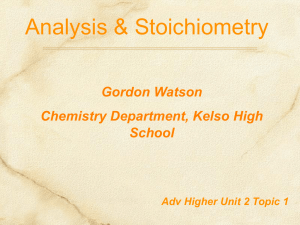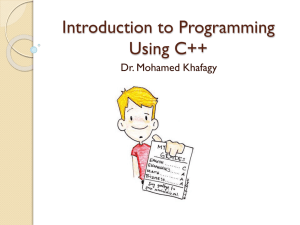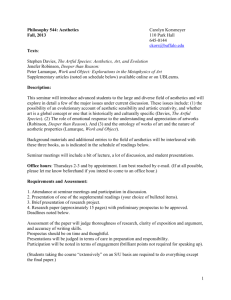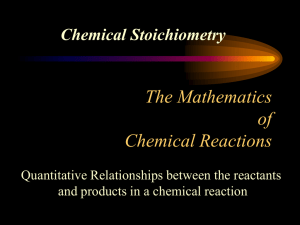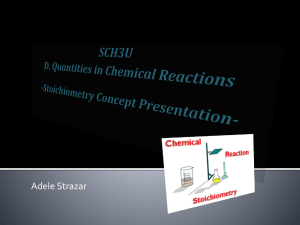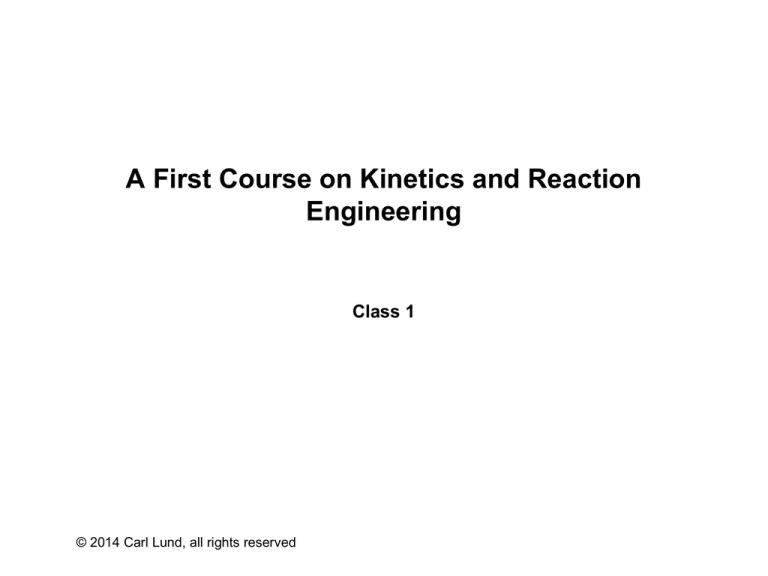
A First Course on Kinetics and Reaction
Engineering
Class 1
© 2014 Carl Lund, all rights reserved
Today’s Agenda
• Why Are We Here?
• Course Logistics
‣ UBLearns
‣ KaRE TExT web site
‣ Your workflows
-
For classes
For homework
• Where We’ve Been
• Summary Review of Unit 1 of AFCoKaRE
‣ Definitions
‣ Stoichiometry
‣ Reaction Progress
‣ Mole Tables
• Questions, Answers and Discussion
• Learning Activity
‣ Stoichiometry and Reaction Progress
• Where We’re Going
Why Are We Here?
• We are here so that I can help you learn about kinetics and reaction
engineering
‣ Learning is something done by students, not something done to them
‣ You must want to learn and you must make the effort necessary to learn
‣ I cannot learn for you and I cannot cause you to learn, but I can create an environment that is
conducive to learning
• My roles
‣ To help you to learn, i. e. I am your “coach” for learning kinetics and reaction engineering
- Readings and Videos
Complete before class (these are the “lectures” for the course)
Online quiz due before the start of class
Review, Q&A at the start of class
- In-class learning activities (mostly problems)
- Homework problems
Selected assignments will be graded for effort, not correctness
- Homework problem solutions
Corrections to selected homework assignments will be graded for completeness
- Practice exams
‣ To assess how much you have learned and how well you have learned it
- Exams
•
•
•
•
•
• Your grade will be based upon the effort you put forth as well as what you
have learned
CE 329 Course Logistics
• Two Primary Resources for CE 329
‣ UBLearns
-
https://ublearns.buffalo.edu/
‣ AFCoKaRE web site
-
http://www.eng.buffalo.edu/Research/karetext
• UBLearns Resources by UBLearns Heading
‣ Announcements
‣ Course Information
-
syllabus, schedule, academic integrity statement
‣ Contacts
-
contact info, including office hours, for me and for TA(s)
‣ Course Documents
-
documents to be used in class (available before class)
slides used in class and solutions to in-class examples (available after class ends)
solutions to homework assignments (available at 10:00 AM on due date)
solutions to exams (available after all students have taken the exam)
solutions to homework and exam problems from 2012 and 2013
•
•
•
In 2012, homework was assigned and due for almost every class meeting
In 2013 homework was assigned once per week
Prior years’ assignment numbers will not correlate to this year’s assignment numbers
CE 329 Course Logistics
• UBLearns Resources by UBLearns Heading (continued)
‣ Assignments
-
Pre-class readings and videos from AFCoKaRE Site
Quizzes (to be answered on-line prior to class)
Assignment statements (as .pdf files)
‣ Gradebook
-
I will try to keep scores up to date throughout the semester
Course letter grade estimates will be provided after each exam
• The AFCoKaRE web site
‣ Provides the “textbook” for the course in the form of
-
Learning objectives for each lesson
Readings (informational and illustrational) for each lesson
Video “lectures” (informational and illustrational) for each lesson
A summary of the equations introduced in each lesson
Practice problems (i. e. problems that can be assigned as homework)
‣ Other learning resources for use in or out of class including
-
Simulators
“How-to’s”
Sample/template computational files (Excel, Maple, MATLAB, etc.)
Supplemental readings
Your Expected Workflows for CE 329
• Before Class Meets
‣ Complete KaRE TeXT Units assigned for that class (read informational and example readings,
watch informational and example videos, write down any questions you have on the material)
‣ Complete the online quiz for that class meeting
-
Online answer forms will cease to be available at 9:00 AM on the due date
‣ On practice exam days, take the practice exam (sometime prior to class) as if it were the actual
exam
• During Class
‣ Ask any questions that you have from your pre-class completion of the assigned units
‣ Participate in learning activities
-
Ask questions whenever something is not clear
Help fellow students who are having difficulty with a particular point
Volunteer when called upon to participate
• After Class Ends
‣ Make sure you can fulfill the learning objectives listed in the AFCoKaRE Unit
‣ Work on homework assignments
-
Complete and submit the next solution that is due
Correct the most recently submitted solution and submit your corrections
Your CE 329 Homework Workflow
• CE 329 homework is designed to be a learning tool, not an assessment
•
tool
There will be homework assignments due at the start of most classes
‣ Submit through UBLearns; late submissions not accepted
• You are permitted to work with others
‣ You must submit your own solution, your name at top; others you worked with also listed
‣ You are encouraged to solve problems yourself, seeking help only when you get stuck
• Submission, correction and grading process
‣ Submit each assignment electronically by the due date and time
‣ Immediately after an assignment is due, the solution will be posted
-
Go through the solution you submitted and mark each place where you made a mistake
and show how to correct that mistake
‣ Submit your corrected solution by the due date and time
‣ Five of your submitted assignments will be selected at random and graded for effort
-
Not the same five as other students
‣ Five of your submitted corrections will be selected at random and graded for completeness
-
Not the same as the five that were graded for effort
Not the same five as other students
How CE 329 Classes Will Work
• Sit with your current class partner at the start of class
‣ You have been assigned a class partner
‣ Your class partner will be changed five times during the semester
‣ If your class partner is absent, find another person who’s partner is absent and pair with them
for that class
• Attendance will be taken
• At the appropriate time, work on learning activities with your class partner
‣ Bring a laptop or hard copies of the redacted slides for the class
‣ Bring paper to write joint responses as appropriate for that day’s learning activities
-
Do not use pages torn out of spiral-bound notebooks, it will jam in the document feeder
when being scanned after class
-
Any pages that jam for this reason will not be scanned and you will not receive credit
‣ At the end of class, submit your work
-
It will be scanned for grading right after class
You may pick it up after it has been scanned; details to follow
• Your work will be graded for effort, not for correctness
• Complete solutions will be available after class on UBLearns, either on the
complete slides or as separate documents
‣ Use them as you deem appropriate to assess how well you have learned the subject material
Why So Different from Most Classes
• To make learning easier and more efficient and to foster deeper
•
understanding
When do you learn?
‣ Not much during a lecture
‣ You learn when you attempt to solve a problem, without following the solution to a similar
problem, and you get stuck
- You already have learned the things before the point where you got stuck
- “Getting stuck” reveals concepts and subtleties that you do not fully understand
• With the approach used in this class, you encounter the things you don’t
fully understand in the classroom where there is an expert ready to help
you fill in the missing understanding
‣ Not late at night, right before an exam or assignment due date
‣ Not alone or with equally uncertain peers as your only source of help
• But it only works, or at least it works much better, if you follow the
workflow I’ve laid out
‣ If you come to class without having done the readings and watched the videos, the
effectiveness of the approach becomes more like the traditional way of teaching and learning
Academic Integrity
• See UB Learns Course Information Section
‣ Print out a copy of the course policy, sign it and turn it in with your first homework solution
• You are permitted to collaborate on homework solutions and corrections
‣ But do so at your own peril; you alone will be responsible for knowing the material on exams
• You are not permitted to collaborate on quizzes, but they are “open book”
• You will get an F in the course if you are caught cheating on an exam
• Exam Day Procedures
‣ Place all coats, hats, phones, calculators, backpacks, etc. at front of room
-
includes your cellphone which should be silenced
‣ Go to the bathroom before class; once the exam starts, you may not leave the room without
turning in your exam (you may not return and resume working on it)
‣ Spread seats as far apart as possible
‣ Only allowed pencils/pens and erasers at seat
CE 329 Grading
• The fraction of the maximum possible points earned for each of the
following course components will be calculated and used as the indicated
percentage of your final course score
‣ Mid term exams (total of 3) - 50%
‣ Final exam - 25%
‣ Graded assignments (total of 5) - 6%
‣ Graded corrections (total of 5) - 6%
‣ Quizzes - 5%
‣ Class attendance - 2%
‣ Class participation - 2%
‣ Non-graded assignments - 2%
‣ Non-graded corrections - 2%
• Grades will be based on the percentiles of a normal distribution with the
class average and standard deviation
‣ ≥ 90th percentile = A; ≥ 70th percentile = B; ≥ 40th percentile = C; ≥ 20th percentile = D
• Guarantee, irrespective of your percentile as determined above, if you
earn the indicated percentage of the maximum possible points
‣ ≥ 90% = A; ≥ 80% points = B; ≥ 70% points = C; ≥ 60% points = D
Where We’ve Been
• Part I - Chemical Reactions
‣ 1. Stoichiometry and Reaction Progress
‣ 2. Reaction Thermochemistry
‣ 3. Reaction Equilibrium
• Part II - Chemical Reaction Kinetics
• Part III - Chemical Reaction Engineering
• Part IV - Non-Ideal Reactions and Reactors
Unit 1 Summary/Review
• Fields that Involve Chemical Reactions
‣ Kinetics – field of science concerned with understanding and modeling the rates of chemical
reactions
- The resulting model is called the rate equation or rate expression
‣ Reaction Engineering – branch of chemical engineering concerned with understanding and
modeling chemical reactors
- Reaction engineering models are called design equations and are comprised of mole
balances, an energy balance and a momentum balance
- Rate expressions (kinetics models) appear within the design equations (reaction
engineering models)
‣ Reaction Thermodynamics includes equilibrium analysis and energy changes associated with
reactions
• Chemical Reactions
‣ Involve bond breaking and forming among reactants and products
- No atoms gained or lost so reaction must be “balanced”
‣ Written similar to mathematical equations except arrows instead of equals sign
-
Use the symbol νi,j to denote the stoichiometric coefficient of species i in reaction j
•
•
If i is a reactant, νi,j < 0
If i is a product, νi,j > 0
‣ Some biological phenomena, including cell growth and enzyme-catalyzed reactions, can be
treated in a manner analogous to chemical reactions
- Nomenclature can be different
- Cell growth doesn’t have a fixed stoichiometry; use an effective stoichiometry
Characterizing How Far a Reaction has Gone
(Reaction Progress)
• Extensive and Intensive Variables
• Reaction Progress Variables
‣ Single reaction: extent, conversion, etc.
xj
n -n )
(
=
ni0 - ni
fi =
ni0
0
i
i
n i, j
‣ Multiple reactions: extent, yield, selectivity, etc.
N ind
ni = ni0 + ån i, jx j
j=1
-
Complete mathematically independent sub-set of the reactions that are taking place
‣ Reversible reactions: fraction of equilibrium conversion
• Limiting Reagent: the one that will run out first
• Mole Tables
Species
Initial Moles
Final Moles
i
ni0
n + å n i, jx j
⋮
⋮
⋮
Total
ån
N ind
0
i
j=1
0
i
all i
æ 0 Nind
ö
å çè ni + ån i, jx j ÷ø
all i
j=1
Questions?
Reaction Progress Learning Activity
• Consider the reaction 4 NH
+ 5 O2 → 4 NO + 6 H2O taking place in a
closed, constant volume reactor (V = 1 L). At the start of the process, the
reactor held one mole of NH3 and 0.15 mole of O2.
3
• To solve some problems in this course, you will need to write an
expression for the concentration of O2 in terms of the concentration of NH3
and the initial composition of the system.
• To solve other problems (in Part I of the course) you will need to write
expressions for the mole fractions of each of the four species (NH3, O2,
NO and H2O) in terms of the extent of the reaction and the initial
composition of the system.
• To solve still other problems in this course, you will need to calculate the
concentration of O2, given the fractional conversion of NH3 and the initial
composition of the system.
Identifying Stoichiometry Problems
• To succeed, you need to be able to
‣ Read a problem statement and analyze it to determine what type of problem it is
‣ Know how to approach each particular problem (without reference to solved examples, etc.)
• Chemical reactions will be central to almost every type of problem in this
course
‣ As we progress through the course new problem types will be encountered
‣ Each time this happens, the associated learning activities will provide some guidance on how
to identify the new problem type and how to approach the solution of the problem
• Stoichiometry problems are introduced in Unit 1
‣ Key features of typical reaction stoichiometry problems
-
The reactions taking place are known
-
The problem entails finding values or expressions for other, unknown quantities related to
the final composition or the progress of reactions
The initial composition of the system is known
One or more quantities related to the final composition or the progress of the reactions
taking place are known
‣ Solving stoichiometry problems is sometimes a step within larger problems
-
Calculation of equilibrium compositions (Unit 3 of AFCoKaRE)
Analysis of kinetics data (Section C of Part II of AFCoKaRE)
General Approach to Stoichiometry Problems
• Identify a complete, mathematically independent sub-set of the reactions
•
•
that are taking place (see Supplemental Unit S1)
Construct a mole table (optional)
Write the defining equations for each of the quantities given in the problem
statement in terms of the extent(s) of the independent reactions
‣ Most are defined in terms of moles, so write definition in terms of moles and then substitute
expressions for final moles in terms of extents
• Solve for the extents of the independent reactions (as values or as
•
expressions in terms of the given quantities)
Write the defining equations for each quantity you are asked to find in
terms of the extent(s) of the independent reactions
‣ Again, most are defined in terms of moles, so write definition in terms of moles and then
substitute expressions for final moles in terms of extents
‣ Substitute the extents found above to obtain the requested quantities
• See the How-To files provided with Unit 1
Practice Applying the General Approach
to Stoichiometry Problems
• Your group has been assigned one of the three problems for this activity
• Work through the general approach given on the previous slide, applying it
to your problem
‣ Do NOT refer to any solved examples from the readings or other sources
‣ Don’t bother to solve any of the equations that result
‣ Just set the problem up
• If you get stuck, feel free to talk to other groups or to call me over to help
you
• In a few minutes you will combine with other groups and explain your
solution procedure to them
Where We’re Going
• Part I - Chemical Reactions
‣ 1. Stoichiometry and Reaction Progress
‣ 2. Reaction Thermochemistry
‣ 3. Reaction Equilibrium
• Part II - Chemical Reaction Kinetics
• Part III - Chemical Reaction Engineering
• Part IV - Non-Ideal Reactions and Reactors



